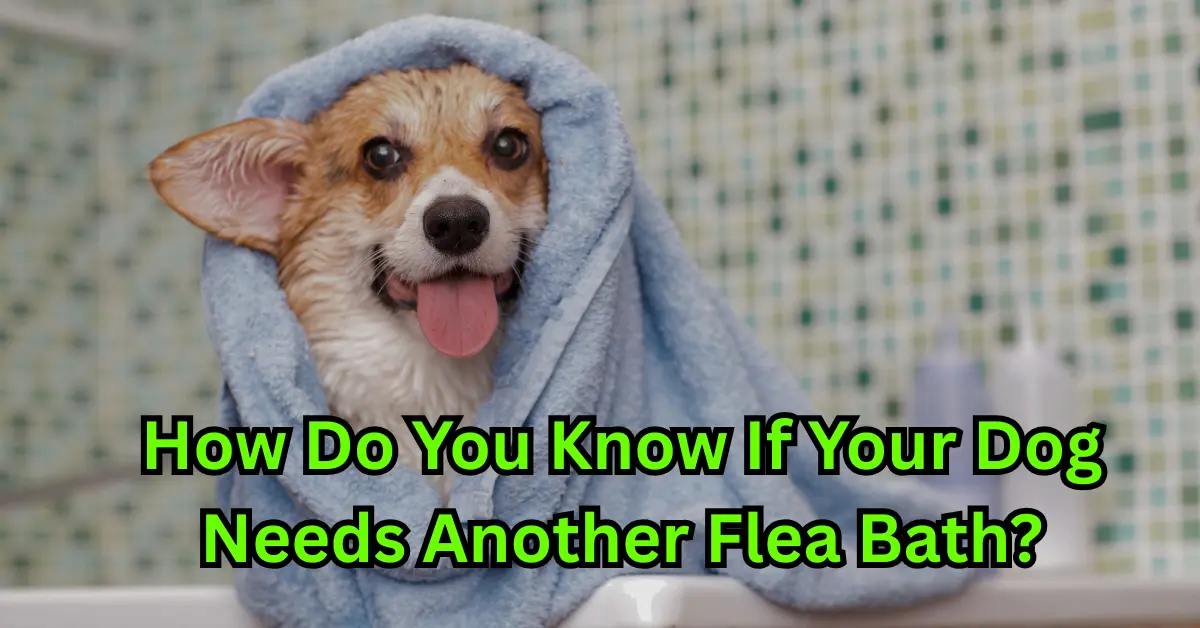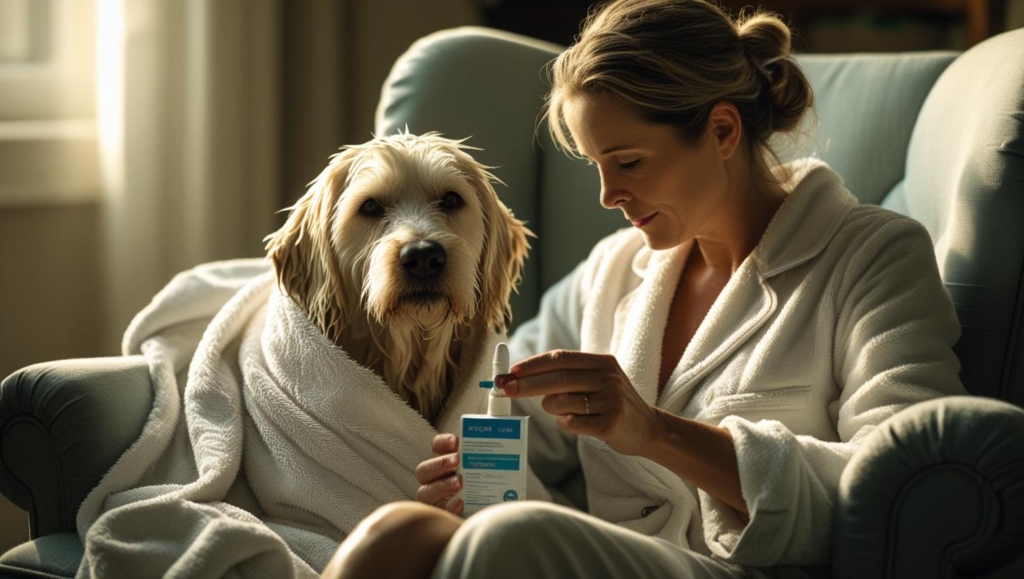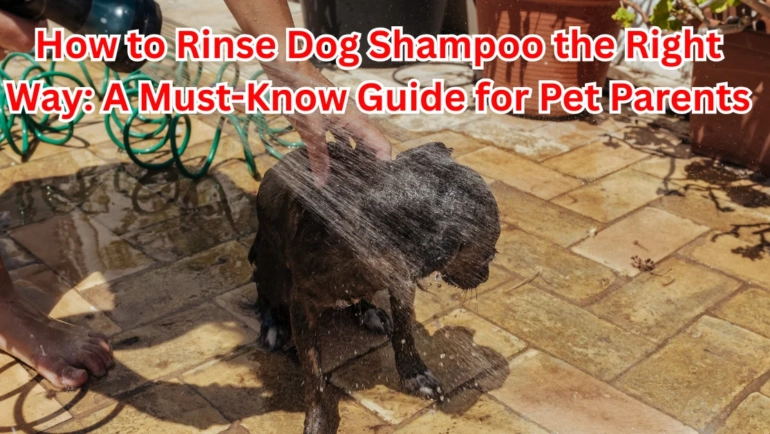
Dog Flea Baths: How Often Should You Give Your Dog a Flea Bath?
Ever watched your dog scratch nonstop and felt totally helpless? It’s heartbreaking, like watching a loved one suffer and not knowing how to make it stop. Fleas can turn your happy pup into a miserable, itchy mess and they can drive you up the wall too. You might be thinking, “Should I give them another flea bath? Is it too soon? What if I’m doing more harm than good?” You’re not alone in this.
In this post, we’ll walk you through exactly how often to bathe your dog for fleas, how to do it safely, and how to keep those pesky critters from coming back for good.
What Is the Best Flea Shampoo for Dogs?

The best flea shampoo for your dog is one that’s both safe and effective for their skin and age. Not all flea shampoos are created equal, and choosing the wrong one can do more harm than good.
When my dog, Rumi, had her first flea problem, I was completely overwhelmed. I stood in the pet store aisle staring at a wall of shampoos, natural ones, chemical ones, ones with names I couldn’t pronounce. All I wanted was something that would help her stop scratching and feel better fast.
Vet-Recommended Options Work Best
Always talk to your vet first. They know your dog’s health history and can suggest a shampoo that suits their needs. In my case, our vet recommended Adams Flea and Tick Shampoo. It worked well and helped ease Rumi’s itching within a day. Sentry Flea and Tick Shampoo is another trusted name that many pet parents rely on.
These shampoos not only kill fleas but also help calm irritated skin. They’re usually the most balanced choice between strength and safety.
Natural vs Chemical-Based Shampoos
If your dog has sensitive skin or allergies, natural shampoos might be the better pick. These use ingredients like peppermint, eucalyptus, or cedar oil to repel fleas gently. I tried one of these early on, and although it smelled great and left Rumi’s fur super soft, it didn’t fully solve the problem on its own.
Chemical shampoos, on the other hand, are stronger and act faster. They often contain ingredients like pyrethrin, which kills fleas on contact. These are better for more severe infestations but should be used with care, especially on dogs with sensitive skin. For us, the chemical shampoo recommended by our vet made all the difference to just one bath, and Rumi was finally able to sleep peacefully again.
What Ingredients to Look For
Check the label before you buy. Ingredients like pyrethrin are commonly used in effective flea treatments. Just be sure not to overuse it. For natural options, look for safe essential oils, but never assume all oils are pet-safe. Some, like tea tree oil in high concentrations, can be toxic.
I once almost bought a “natural” shampoo with a long list of oils, thinking natural meant harmless. Thankfully, I checked with our vet first. Turns out, a few of those oils could have made Rumi sick.
Puppy-Safe Shampoos Matter
If you have a puppy, be extra cautious. Most flea shampoos are only safe for dogs 12 weeks and older. Never use adult flea products on younger pups. Their skin is too sensitive, and the ingredients can be too strong for their small bodies.
When Rumi was still a puppy, we had to hold off on any flea shampoo and rely on vet-approved alternatives. That waiting period was stressful, but keeping her safe was more important than acting fast.
Can You Give a Dog Too Many Flea Baths?
NO, giving your dog too many flea baths can cause more harm than good. While it might feel like the right move when fleas are a constant problem, overbathing can actually damage your dog’s skin and coat.
Flea shampoos are designed to kill pests quickly, but they can also be harsh, especially when used too often. Most contain active ingredients that, while effective, can strip away the natural oils your dog’s skin needs to stay healthy.
Too many baths can lead to skin irritation, dryness, and discomfort. If your dog starts showing signs of overbathing, it’s time to pull back.
Signs You May Be Bathing Your Dog Too Often
Watch closely for the following symptoms. They’re often the first signs that your dog’s skin is not coping well with frequent baths.
| Sign of Overbathing | What It Means for Your Dog |
| Dry, flaky skin | Natural oils are stripped from the skin |
| Itching or redness | Skin is irritated or inflamed |
| Excessive scratching | Trying to relieve discomfort |
| Dull or rough coat | Lack of moisture and natural shine |
| Sensitivity to touch | Skin might be sore or raw in certain areas |
If you notice any of these symptoms, it’s a good idea to pause the baths and let your dog’s skin recover.
What to Do Instead
Instead of relying solely on flea baths, use a more balanced approach. Talk to your vet about oral or topical flea preventatives. These treatments work from the inside out and are often more effective and gentler than frequent shampooing.
Also, don’t forget the environment. Fleas spend most of their life cycle off your dog. That means you need to treat their surroundings too. Wash your dog’s bedding regularly with hot water and vacuum your carpets and upholstery at least twice a week during an infestation. This reduces reinfestation and helps control fleas long term.
Finding the right rhythm is key. In most cases, a flea bath once every few weeks; combined with vet-recommended flea control and a clean home; does the job without harming your pup’s skin.
How Often Should You Give Your Dog a Flea Bath?

You should give your dog a flea bath only as often as needed to manage fleas without irritating their skin. Timing matters. Too many baths can do more harm than good, while too few may leave the fleas in control.
Finding the Right Balance
If your dog is dealing with an active flea infestation, a flea bath once a week is usually enough to help reduce the flea population. This gives the shampoo time to work without drying out the skin. For most dogs, one to two baths per week during an outbreak is the maximum safe limit.
Once the infestation is under control, or if you are simply trying to prevent future problems, reduce the frequency. A flea bath every 2 to 4 weeks is typically effective for prevention. This can vary depending on your dog’s lifestyle. If they spend a lot of time outside or around other animals, more frequent baths may be needed. If they stay mostly indoors and are already on flea preventatives, fewer baths will do.
Don’t Rely on Baths Alone
Flea baths are helpful, but they’re not a one-size-fits-all solution. They kill adult fleas but do little to stop eggs or larvae from coming back. That’s why vets often recommend combining baths with a longer-term flea control plan. This might include oral medications, topical treatments, or even natural repellents, depending on your dog’s needs.
Factors That Change How Often You Should Bathe
Several things affect how often your dog really needs a flea bath. The severity of the infestation is the first. In the early stages of Rumi’s flea problem, she was scratching constantly. We had to stick to a weekly bath schedule just to give her some relief. But once the fleas were mostly gone and we started using a vet-approved topical treatment, we were able to cut back to one bath every few weeks.
Your dog’s skin type matters too. Dogs with sensitive or allergy-prone skin might not tolerate even weekly baths. In that case, a gentle flea shampoo, or an entirely different flea management strategy, might be better. Always keep an eye on how your dog reacts. If you notice dry skin, redness, or more scratching after a bath, it’s time to pause and reassess.
The type of flea shampoo also plays a role. Some are made with harsher ingredients designed to kill fleas on contact. Others use natural oils and are gentler on the skin. I made the mistake once of switching to a stronger formula without reading the label. Rumi ended up with a patch of dry skin that took days to heal. Now I always check with the vet first.
Why Less Can Sometimes Be More
It’s natural to want to act quickly when your dog is suffering, but bathing them more often doesn’t always mean faster results. In fact, it can slow down the healing process by stripping away the oils that keep their skin healthy. A consistent, balanced routine supported by the right products will always work better in the long run.
To sum it up, during a flea outbreak, bathe your dog once a week. For prevention, once every few weeks is usually enough, especially if you’re using other flea control methods. Pay attention to your dog’s skin, consult your vet, and stay patient. Fleas are frustrating, but with the right care, they don’t stand a chance.
Should You Bathe Before or After Applying Flea Treatment?
You should bathe your dog before applying flea treatment, not after. This helps the product absorb better and work more effectively.
Why Bathing First Works Best
A bath removes dirt, oil, and debris that can block the treatment from reaching your dog’s skin. Always wait 48 hours after the bath before applying any topical flea product.
I once applied for treatment right after Rumi’s bath, thinking it’d be more effective. It didn’t work. Our vet explained that the natural oils need time to return, or the treatment can’t spread properly. Lesson learned.
What About Bathing After Treatment?
Some flea treatments are waterproof, but not all. Most need 24 to 72 hours to fully absorb before your dog can safely get wet again. Always check the label for exact timing.
The treatment needs time and a clean surface to work. Rushing either step can reduce its power or wash it away too soon. Bath first, wait 48 hours, apply, then avoid another bath for a few days.
How Do You Know If Your Dog Needs Another Flea Bath?

You’ll know your dog needs another flea bath if the itching returns or you start spotting fleas again. These are the clearest signs that the last bath didn’t fully eliminate the problem.
When the Scratching Comes Back
One of the first things I noticed with Rumi, even after what I thought was a successful bath, was that she started scratching again just a few days later. It wasn’t constant, but it was enough to raise concern. That’s when I checked her fur and found a few tiny black specks, flea dirt. Sure enough, the fleas were back.
When you see your dog scratching more than usual, especially around the base of the tail or neck, it could mean a second wave of fleas has arrived. Sometimes, even after a flea bath, eggs and larvae survive in your dog’s bedding or your home. This is why regular checks are just as important as the bath itself.
Spotting Fleas or Flea Dirt
If you part your dog’s fur and see adult fleas or what looks like tiny black grains of pepper, that’s flea dirt. You can confirm it by putting a few specks on a wet paper towel. If they turn reddish-brown, it’s dried blood from flea bites. This is a clear sign that another bath may be necessary.
That happened to me once with Rumi when we thought the problem was gone. But then we saw the dirt on her bed again. That was our sign to take action right away.
Are Flea Baths Enough on Their Own?
Not always. Flea baths are great for killing adult fleas, but they don’t stop new ones from jumping on later. If you’re still seeing signs of fleas a few days after a bath, it’s time to consider stronger, longer-lasting options.
We eventually added a monthly topical treatment after our vet suggested it. It made a huge difference. Rumi’s scratching stopped almost completely, and we didn’t have to keep bathing her as often.
Some vets may also recommend products that break the flea life cycle, like Insect Growth Regulators. These stop the eggs and larvae from developing into biting adults.
Are Flea Baths Safe for Puppies?
Flea baths can be safe for puppies, but only if you use the right shampoo. Puppies have more sensitive skin and can react badly to adult flea products.
When Rumi was still very young, we avoided flea shampoos altogether. Our vet advised us to wait until she was at least 12 weeks old. Until then, we focused on keeping her bedding clean and used a flea comb daily. Once she was old enough, we switched to a gentle puppy-safe flea shampoo, which worked well without irritating her skin.
Always talk to your vet before using any flea treatment on a puppy, especially if they are under 12 weeks old. In many cases, oral or spot-on treatments might be safer and more effective than bathing.
How Long Does a Flea Bath Last?
A flea bath doesn’t offer long-term protection. It kills the fleas that are currently on your dog, but once your dog goes back outside or lies on an untreated surface, new fleas can hop right back on.
In most cases, the effects of a flea bath last anywhere from 1 to 7 days. That’s why it should be used as part of a larger flea control plan.
After learning this the hard way, we began treating our home along with Rumi. We vacuumed daily, washed all her blankets, and even treated the carpets. That extra step made a big difference in how long she stayed flea-free after a bath.
Signs You’re Overbathing
While flea baths are helpful, doing them too often can cause problems. If your dog starts showing signs of skin irritation, you may be overdoing it.
Dry skin, flaking, and a dull coat are all signs your dog’s natural oils have been stripped away. If they seem more itchy after a bath, that’s another red flag.
That happened to Rumi once when I used flea shampoo two weeks in a row without checking her skin first. She started licking her paws more and her coat looked rough. We took a break from bathing and focused on her skin recovery with a soothing balm and vet-recommended diet changes.
Can I Use Flea Shampoo Every Week?
Generally, no. Using flea shampoo every week is not recommended unless your vet tells you otherwise. Most dogs do well with a bath every 1 to 2 weeks during an infestation. Anything more than that can dry out their skin and actually make things worse.
For long-term control, it’s much better to combine flea baths with monthly preventatives like oral or topical treatments. That way, you protect your dog without having to rely on frequent shampoos.
Conclusion
Flea baths can be a powerful way to help your dog find relief, but like everything, they work best when used with care. Throughout this post, you’ve learned how to spot the signs, how often to bathe, and when it’s time to try something else. And most importantly, you’ve learned that you’re not alone in figuring all this out.
Fleas can make both you and your pup feel frustrated and helpless, but you’re doing the right thing by learning and taking action. With the right routine and a little patience, your dog can get back to being their happy, itch-free self.
Keep going. Trust your instincts. And when in doubt, ask for help. You’ve got this, and your dog is lucky to have you.
Quick Answers to 10 Common Flea Problems
1. Can Fleas Live in My Home Without a Pet?
Yes, fleas can survive for weeks in carpets, bedding, or furniture, even without a pet present. Regular cleaning helps prevent infestations.
2. How Long Do Flea Eggs Take to Hatch?
Flea eggs can hatch in as little as 2 days under warm conditions. This is why treating the home environment is just as important as treating your dog.
3. Is It Safe to Use Human Shampoo to Kill Fleas?
No, human shampoo isn’t formulated for dogs and won’t kill fleas. It can also irritate your dog’s skin. Always use vet-approved flea shampoos.
4. Do Fleas Die in Cold Weather?
Fleas slow down in cold temperatures but don’t die off completely. They often survive indoors during winter, so year-round protection is best.
5. Can I Comb Out Fleas Instead of Bathing?
Flea combs can help remove fleas and flea dirt, but they’re not enough on their own. Use them alongside other treatments for best results.
6. Do All Dogs React the Same to Fleas?
No, some dogs are more sensitive to flea bites than others. Even one bite can cause severe itching or allergic reactions in some pets.
7. Will One Flea Bath Solve the Problem?
One flea bath may kill adult fleas but won’t stop new ones from appearing. A consistent treatment plan is needed to break the flea cycle.
8. How Can I Tell If Flea Shampoo Is Working?
You may notice fewer fleas, less scratching, and improved skin. Check the water during the bath, dead fleas often wash out visibly.
9. Are Natural Flea Remedies Effective?
Some natural remedies can help but may not be strong enough for infestations. Always consult your vet before trying natural flea products.
10. Can Fleas Affect My Family Too?
Yes, fleas can bite humans, especially around ankles. While they don’t live on people, they can cause discomfort and spread quickly in the home.



